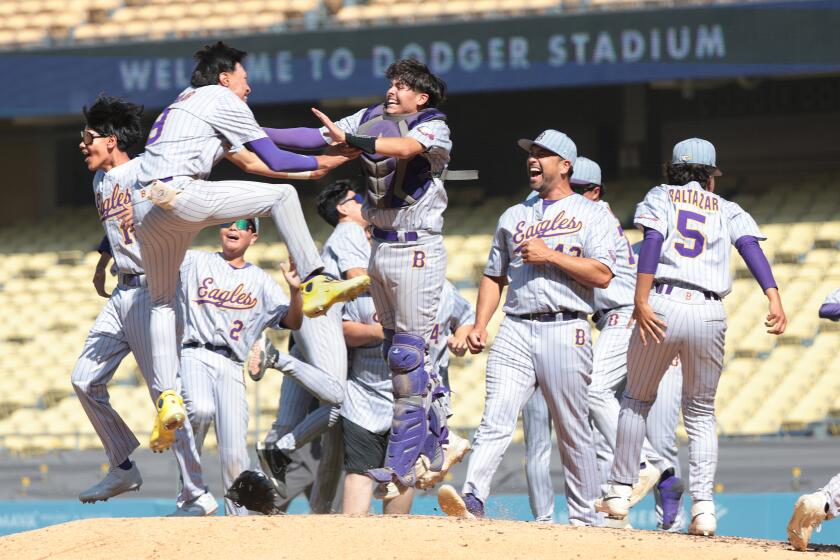New York Frame of Mind
- Share via
My TV flashed the final moments of yet another Laker loss, the 14th in their first 23 games last season, to the struggling Golden State Warriors. I resigned myself to that fact that in 15 hours Phil Jackson would be in no mood to reflect on the good old days with the New York Knicks.
But Jackson had agreed to meet with me after practice the next day, so off I went to El Segundo. Big-time tension in Lakerland: Kobe this, Shaq that, Phil the other. Finally, after all the pens and tape recorders had stopped and the army of minicams had left the gym, Phil pointed his finger at me and said, “You ready?”
And for the next two hours, I learned that no matter what the current mood or crisis, few things are closer to Phil Jackson’s heart than his years as a New York Knick, and how his training under the legendary Red Holzman served as the foundation for a coaching career that would produce a record-tying nine NBA championships and counting.
In time, Jackson would become a key player during the Knicks’ glory era. His reputation as the iconoclastic mountain man, his bushy hair and coat-hanger shoulders stood in contrast to his more celebrated teammates: stoic Willis Reed, flashy Walt Frazier and Earl Monroe, blue-collar specialist Dave DeBusschere, future politician Bill Bradley, memory expert and rebounder extraordinaire Jerry Lucas. At 6 feet 8, Jackson was a defensive specialist whose flailing arms and legs were an inbounder’s nightmare.
Jackson was a second-round pick out of North Dakota in a 1967 draft that also brought Frazier to New York. But after making the NBA’s All-Rookie team in 1968, he suffered a back injury that sidelined him for a year and a half, including the Knicks’ first championship season in 1969-70. He returned to the lineup the next year.
Jackson played 10 seasons as a Knick, including the team’s second championship year of 1972-73, when they beat the Lakers in five games in the Finals. He played in 732 games for the Knicks, a total surpassed only by Patrick Ewing, Carl Braun, Frazier and Bradley.
Those who followed that team closely considered Jackson its least likely member to make basketball his lifelong career. DeBusschere had already been a coach and would go on to a front-office career. Reed and Dick Barnett would coach as well. Bradley, of course, would run for president of the United States. But Jackson? This was a guy whose idea of a dream day at Madison Square Garden was playing a Knick game in the afternoon and then going downstairs to the Felt Forum for a Grateful Dead concert that night.
How little we knew. Because through all that time, Holzman, the old coach who had learned the game on the streets of New York, was nurturing a star pupil.
“Ever since I’m injured [in late 1968], Red has me go out and scout,” Jackson told me that day. “If we’re on the road and if the home team has a game the night before we’re supposed to play them, Red says to go over and catch that game, and put some stuff on the board tomorrow.
“Red never X’d and O’d. He never drew or diagrammed any plays. I don’t know if he used salt shakers or something on the table; I just never saw him do it. ... But he asked me to draft up a team book. So whenever we’d get a new player, they’d come see me and I’d have this mimeographed book of plays.”
Lucas recalled Holzman’s ability to get results from a diverse collection of players and personalities, something he said was passed on to Jackson.
“Think about the backgrounds of all the players, where we all grew up, where we were from, the kinds of lives we led, where we had been. We were all different people. Red had the knowledge and the ability to handle that situation,” Lucas said. “That’s what set him apart from other coaches, and I think that’s something that Phil Jackson learned at that time in his life and was able to mold into his career, and that’s what made him one of the greatest coaches of all time.”
Jackson remembered Holzman, who died in 1998, as “very demonstrative,” as well as his emphasis on defense.
“He said it was all about defense, and we were going to learn how to play defense together. Because once you learn how to play defense, you can play offense,” Jackson said. “As we got going and I got more responsibility as a player, there were things he’d tell me that became significant to me ... little things about people and personnel. Red had a way about him that was endearing to me.”
If any of today’s Lakers feel that the head man judges them a bit too harshly, they should remember it’s nothing the coach hasn’t gone through himself.
“I was [Holzman’s] whipping boy,” Jackson said. “If he needed somebody to rally the troops around, he could start yelling at me about a variety of things ... whether I gambled on defense or I made a mistake on offense or took a shot that maybe I shouldn’t have, or whatever. And I was the combative one, and then we’d get into an argument.
“Then DeBusschere and Bradley would get me aside and say, ‘Don’t argue with him. Don’t say anything back because he just needs someone to vent towards.’ And I didn’t like to be the one who was vented at. But with my pecking order on the club, it was natural to do that. And as you find out when you’re the coach, it’s nice to have a player you can use to be a motivator on the team.”
Reduced by injury to spectator status during the 1969-70 season, Jackson’s biggest tangible contribution was a coffee table-style photo book on the title run called “Take It All!”
George Kalinsky, the longtime Garden photographer and Jackson’s co-author, recalled that Jackson was in full mountain-man mode the day they first met with their publisher.
“Phil meets me downstairs dressed in shorts, sandals, a T-shirt hanging out, and I’m thinking there’s no way we can walk up to this guy’s office with him dressed like this,” Kalinsky said. “I’m in a suit, and I said, ‘Phil, I don’t think that a hippie from North Dakota is going to be able to get a book deal dressed like this.’ Phil said not to worry about it. We go up, walk in and sit down. We introduce ourselves and start talking, and within the first 30 seconds, it turns out that this senior editor is from North Dakota and he’s a Phil Jackson fan. So I’m sitting there saying to myself, ‘It’s a deal!’
“Phil came over to my house, and in my den I had all the pictures laid out on the floor. Phil just lies down on the floor with a legal pad and said, ‘Let’s do it.’ This is on a Saturday afternoon. By Sunday night, we had the book finished.”
Jackson’s Knick days ended when he was traded to the New Jersey Nets in 1978. He got his first official taste of coaching as a Net assistant under Kevin Loughery and Bob MacKinnon, but for his mentor, that wasn’t quite enough.
“[Holzman] told me that one of the best places to coach is Puerto Rico. It’s a game and a place where the energy is so intense, the language skills are different,” Jackson said. “It’s just basketball in its rawest form, and you learn to coach off the seat of your pants. And I ended up coaching in Puerto Rico for 4 1/2 years.”
*
Dennis D’Agostino is the Knicks’ team historian and the author of “Garden Glory: An Oral History of the New York Knicks” (Triumph Books, 2003).
More to Read
Go beyond the scoreboard
Get the latest on L.A.'s teams in the daily Sports Report newsletter.
You may occasionally receive promotional content from the Los Angeles Times.










